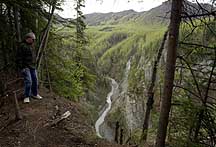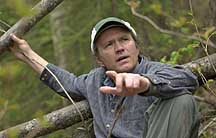Anchorage Daily News
EKLUTNA -- Marc Lamoreaux, natural resources director for the Native
Village of Eklutna, last week led a team of soil scientists, biologists
and hydrologists to a scenic overlook above Eklutna River, about a mile
from the Glenn Highway.
Some 250 feet below, they spotted mangled cars and mashed home
appliances piled high on the side of the river or upturned in the middle,
where they had landed after being rolled or shoved over the cliff.
Eklutna hopes this summer to clean up this illegal dump, assuming the
tribe gets a $70,000 grant from the federal Environmental Protection
Agency to pay for the work. And once the dump is gone, Eklutna has even
bigger plans.
The tribe wants to remove an old dam, deepen some of the river's ponds
to make better fish habitat, and take back some of the river's water that
was long ago allocated for drinking or hydropower. The goal is to restore
the river and bring back its once healthy salmon runs.
"We're trying to make sure the fish come back," said Lee Stephan, chief
executive officer of the Native Village of Eklutna.
Stephan said Eklutna villagers would have more salmon for subsistence
and possibly enough to attract tourists to a not yet built RV park, luring
them with sportfishing.
"Where there's fish, there's people," Stephan said.
For decades, Southcentral residents have sent cars and other objects
hurtling off the cliff into the Eklutna River gorge. Worse for the fish,
the stream has been dammed and diverted and its banks mined for gravel.
Its mouth has been moved no fewer than five times because of various
projects, Lamoreaux said.
Once as large as Ship Creek, Eklutna River today carries just a
fraction of its original flow, Lamoreaux said.
"Everyone keeps saying it's not ours, not ours," Stephan said.
If cleaning junk cars from a stream seems a straightforward, even
ordinary goal, some of Eklutna's other ideas are bold.
Lamoreaux plans to study taking out a defunct 68-foot-tall hydropower
dam, built in the 1920s, near the point where the river leaves its
mountain home and winds across the flats toward Cook Inlet.
Lamoreaux said he's asked the military about blowing the dam up as a
training exercise. Other people suggest the dam might not need to be
removed at all. A sluice gate at the bottom may simply need to be opened,
said Frank Reed, whose father, Frank Ivan Reed, built the dam as a private
venture when Anchorage was just getting started.
But while an attractive idea, removing the dam poses a problem,
Lamoreaux said: It would release the accumulated silt behind the dam,
which could smother salmon-spawning habitat.
A second dam upstream at Eklutna Lake presents a different challenge.
It supplies water and some electricity to Anchorage and the Mat-Su area.
The tribe is going to ask the electric companies that own the dam to leave
more water in the stream.
Almost all the overflow of the lake goes either to the city for its
water supply or to three electric companies -- Municipal Light &
Power, Chugach Electric and Matanuska Electric Association -- that jointly
own the dam. Eklutna River is dry below the Eklutna Lake dam but
regenerates downstream from runoff and a feeder stream, Thunderbird Creek.
To get the work done on a shoestring budget, Lamoreaux has asked for
help from anyone and everyone, from the Sierra Club to the federal
government. A federal grant obtained by the University of Alaska Fairbanks
Cooperative Extension pays for
Lamoreaux's position for the tribe. The DEC, meanwhile, has offered to
help identify and dispose of several drums found at the dump.
Last week, Lamoreaux toured the river with scientists from the Bureau
of Indian Affairs, the National Resources Conservation Service and the
Anchorage Soil and Water Conservation District. All those agencies have
said they will provide technical help.
Eklutna River likely would never support salmon runs as robust as those
at Ship Creek, said Lance Trasky, a regional supervisor with the state
Fish and Game Department's Habitat Division. But if the river's habitat is
improved, the river could provide a modest, healthy fishery, he said.
Stephan said he remembers back in the 1960s when sportfishermen rambled
the riverbanks. He also remembers when he was a child, pinks filled the
river.
These days, Eklutna River is home to just a small fishery, a mix of
silvers, kings, pinks and chums plus trout and Dolly Varden char,
according to Lamoreaux.
Someday the tribe also wants to work on habitat below the old dam.
Lamoreaux said it would help to have more water in the river to flush out
sediments. The tribe might also deepen some of the river's ponds to create
better winter habitat for juvenile fish.
But first on the list is the dump. Lamoreaux said he has talked to a
company that owns a crane with a 70-foot boom and a 300-foot cable. The
crane operator said he thinks the cleanup can be done.
The pile is full of tires, stoves, refrigerators, screen doors, a
propane tank, a lawnmower, a camper home and a twisted Yamaha motorcycle
missing its tires and handlebars.
"Evel (Knievel) didn't quite make the gap," joked Malcolm Ford of the
University of Alaska Fairbanks Cooperative Extension when he spotted the
motorcycle during the river tour.
The debris pile also held a green painted log. Lamoreaux said it was
put up as a barrier to prevent people from throwing things into the gorge.
In its place, Lamoreaux and other people have installed a concrete
berm. Lamoreaux said it has slowed, but not stopped, the illegal dumping.
Reporter Elizabeth Manning can be reached at emanning@adn.com or 257-4323.
River
rehab
Village wants to remove junked cars and other trash and restore
salmon runs![]()
By Elizabeth
Manning
Anchorage Daily News![]()
One by one, the scientists
grasped a tree and peered over the edge.

Bill Wood, state biologist with the National Resources
Conservation Service, takes a wary look into the Eklutna River gorge
to view the illegal dump site. (Erik Hill / Anchorage Daily
News)
Stephan said he
had hoped some other agency would take a lead to restore the river. But no
one except Eklutna viewed it as a priority, he said. The state Department
of Environmental Conservation, for example, said it has worse problems and
doesn't consider the dump a spill.

Marc Lamoreaux, natural resources director for the Native
Village of Eklutna, hopes to land the tribe a grant to remove an
illegal dump from Eklutna River. Lamoreaux also would like to remove
an old dam and restore the river's salmon runs. (Erik Hill /
Anchorage Daily News)